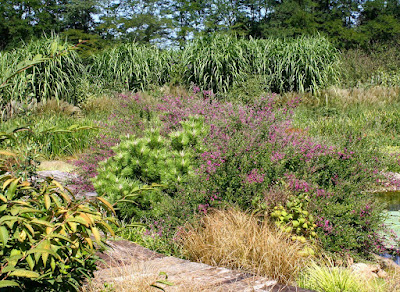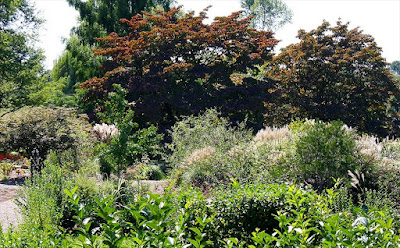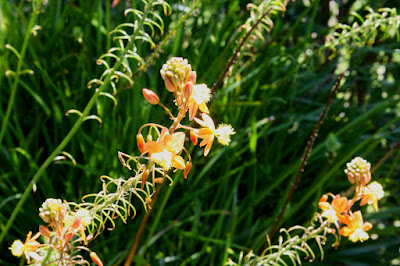I took these photos in early September of 2009. At that time, I believe this garden was only in its second or third season. I think a year of site preparation preceded that, during which Bruce contoured the land, added several ponds linked by streams, fountains and waterfalls, and numerous large rocks, as well as the pumps and conduits to make it all work. This visit was unfortunately at high noon, so the light is as harsh as it gets and the colors aren't nearly as intense as they would be at another time of day.
At this early September visit the Lespedezas were in full bloom.
Above is the central area of the garden. You can see the free use of grasses and carex of many different types, large lespedezas, and evergreen accents, with a view of the Japanese bridge in the far center (painted black, not red), crossing above the largest waterfall. Click on the photos to see the details of the planting, much of which hasn't yet had time to grow in fully.
To the left is a large grass border, using Miscanthus 'Giganteus' to completely obscure the view of the maze garden behind it, smaller miscanthus, irises in profusion and, edging the path, various grasses and carex. Note the path of recycled railroad ties. Bruce has used gravel paths in interesting combinations with other materials, as you'll see below.
The bridge registers almost as negative space with the bright flowering miscanthus behind it.
A groundcover of Japanese blood brass (Imperata cylindrica 'Rubra') with a pennisetum.

Palm sedge (Carex muskingumensis) beside the water.
A view across the pond. Notice the use of many carex.
An interesting pattern using cross-cut "tiles" from timbers.
One large rock as a simple step.
Another planting of Miscanthus and irises.
I'm only guessing, but this may be Carex glauca 'Blue Zinger'.
Another carex planting.
The view from the far side of the pond, from among a grove of trees.
A simple, and elegant, stone bridge ...
downstream from this bubbling pool.
Moving into the maze garden.
Looking back toward the wild garden.





























What a lucky duck you are to have such a gorgeous nursery nearby. I esp. love all the grasses featured! If that was near my house I would probably have to get a job at the place as I would be spending all my free time/money there anyway....
ReplyDeleteChristine in Alaska
He looks to be a very talented designer!
ReplyDeleteYou are fortunate to have such a great nursery so close by. All those grasses(in such an original and fun design) must be a great source for your garden. Perhaps the hedges will inspire you with your hornbeam project.
ReplyDeleteChristine,
ReplyDeleteGrasses and carex are certainly the backbone of the plantings, but I can't predict what he might do this year. Last year an extension of the garden was underway, a new pond with what will be a Japanese influenced bridge to an island in the center, on the far side of the garden. Bruce is rather taciturn, as am I, so I don't really know his ultimate intent, but he's very talented designer, energetic, and a get-it-done person. The work required to shape the landscape, install the ponds and pumps, build that beautiful arched bridge, and do the plantings is amazing. And I didn't mention the koi in the ponds or the sculpted dead trees in the pasture beside the garden. Or the woodland garden.
Tim,
ReplyDeleteYou bet he is.
Michael,
ReplyDeleteI'm looking forward to seeing how it develops in the coming season. Many of the groundcover plants will probably have knit together. Interesting to see what thrives and what goes away too. It's a very sunny, exposed site at present.
James:
ReplyDeleteThe smartest nursery owners are the ones who offer a vista such as this for their customers to view the plants that they sell in their mature fullness.
While this tends toward the opposite end of the spectrum as I am used to,[so much sun and exposed areas] the clever use of grasses is simply stunning. M. 'Giganteus' is stunning in and of itself, but when used to the effect witnessed here.... breathtaking. I hope that you will keep us posted as to the garden's development. It is particularly fascinating to document a garden's transition. Gardeners are indeed a fickle group, but all the more exciting because of it! Wonderful photos. Thanks for inviting your readers along!
Teza,
ReplyDeleteThis is definitely not a garden for shade plants (certainly not your kind of garden), at least not now. I imagine the shade will increase over time, as some of the trees gain size, but it does look to continue as a very sunny garden. Yes, the Miscanthus "Giganteus' is a point of high drama planted en masse as it is here. Seeing the real thing (instead of a little photo), the effect is stunning. There is a shade garden in a grove of trees nearby, perhaps that one for another day.
Thanks for the link. I will have to tell my brother to put this on our list to see when we go up this summer. I love the blood grass-fountain grass combo.
ReplyDeleteLynn, who manages the nursery for Bruce, lives in Kintnersville. I believe that's where your brother lives. That is a really nice plant combination, isn't it?
ReplyDeleteLovely! Wonderful! I'm really getting into carex. And sedges. I have a few palm sedges, of course, in my wet clay. Lovely plants.
ReplyDeleteWe have lots of native carex and sedges. I once took a course in their identification at the nearby Bowman's Hill Wildflower Preserve. There I discovered that identification is a highly specialized field, requiring familiarity with various flower parts, and often a microscope. So I learn the most widely known ones, and buy named varieties. I'd like to try some of the brown New Zealand sedges, but I see conflicting information about their hardiness (zone 6 or 7).
ReplyDeleteGreat tour...I'd love to have a maze someday.
ReplyDeleteI'm hoping to get to some of the Garden Conservancy open day tours this year. If you haven't been, I highly recommend it.
ReplyDeleteWonderful to find your site! Did you know Bruce Gangawer is Honorary Chair of the New Hope Historical Society 17th Annual Garden Tour taking place June 5, 2010. There are 6 private Bucks County gardens on the tour plus a lecture/demonstration at Paxson Hill Farm, Check it out at www.newhopehs.org by clicking on the roses on the home page.
ReplyDeleteFinally catching up on some reading and am so happy you posted this. I haven't ever been and now I will when I head out your way this spring. I always love a new destination reasonably close to home.
ReplyDeleteI didn't know Bruce was Honorary Chair of the Garden Tour. Thanks for letting me know.
ReplyDeleteSusan aka,
ReplyDeletePaxson Hill is a rather magical place. I believe you'll love it.
Nice stuff, I like that sculpture too.
ReplyDelete